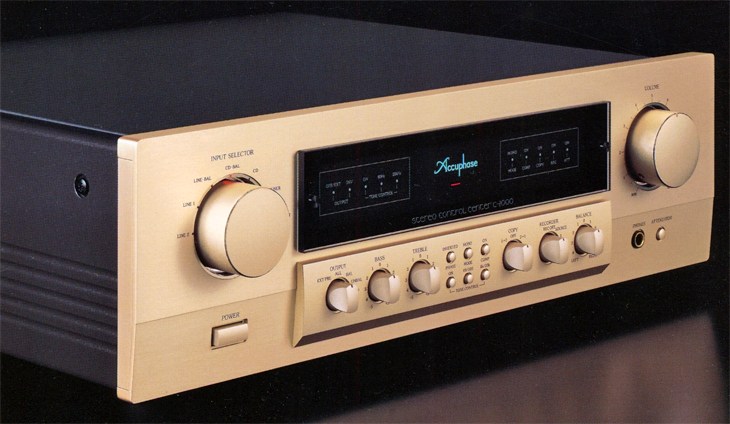
Accuphase C-2000
¥390,000(Released in July 2004)
Commentary
A stereo control amplifier with AAVA volume control, inheriting the design technology of C-2800 and C-2400.
The volume control uses the Accuphase Analog Vari-gain Amplifier (AAVA) method.
AAVA is a pure analog volume control system that combines an amplifier and volume control to provide many performance advantages because the music signal does not pass through a variable resistor. AAVA is composed of highly reliable semiconductor components that enable long-term performance and sound quality.
The AAVA uses 16 weighted V-I conversion amplifiers to convert music signals into current. Each amplifier is turned ON/OFF by 16 power switches. The volume is determined by the combination of these switches. The CPU (microcomputer) controls the knob position and volume to be the same. The combination of these currents is a Variable Gain Circuit that changes the magnitude of the music signal. Each current is combined by an I-V converter to return the voltage.
For volume adjustment with a general variable resistor, impedance increases at the volume position normally used and noise increases. However, AAVA is not affected by impedance changes, so S/N does not deteriorate and frequency characteristics do not change. Therefore, noise does not increase at a practical volume level, so high S/N ratio can be maintained and sound quality does not change. In addition, since a fixed resistor is used, there is almost no difference in volume between left and right even at a minute level. Also, crosstalk between channels can be eliminated because each channel can be made independent.
The volume control detects the volume position by turning position by turning the knob on the panel so that it can be operated with the same feeling as a conventional amplifier. The volume balance between left and right and the attenuator is also controlled by the AAVA so that extra circuits can be eliminated and the configuration is simple.
The C-2000 amplifier circuit consists of a total of five unit amplifiers including an input buffer, an AAVA, and a balanced output. These amplifier circuits are separated into left and right on the board and placed on the motherboard. In addition, power supplies such as power transformers and smoothing circuits are also separated into left and right monaural configurations to prevent interference between the amplifiers.
A logic relay control signal switching circuit is used for input switching to eliminate signal routing and make the shortest and straight signal path.
The tone control circuit uses an additive active filter method.
In this system, the flat signal passes straight through, and variable characteristics are created as necessary to increase or decrease the flat signal, which is advantageous in sound quality.
Both bass and treble can be adjusted by ± 8 dB with 2-stage switching.
Equipped with a compensator that increases the volume of bass sound.
Equipped with a phase switching function.
Equipped with an Ext Pre function that can be switched with an external preamplifier.
Built-in dedicated headphone amplifier circuit for sound quality.
Digital and analog inputs are supported by the option board.
There are three types of optional boards : Digital Input Board DAC-10, Analog Disk Input Board AD-10 -10, and the Line Input Board Line-10.
Two additional boards are available.
Analog Disk Input Board AD-9 and Line Input Board Line-9 can also be used.
Remote Commander RC-20 is included.
Volume adjustment and input selector switching are available.
Model Rating
| Type | Control Amp | ||||||||||||||||||
| Frequency Response (Balanced/Unbalanced input) | 3 Hz to 200 kHz + 0 -3.0 dB 20 Hz ~ 20 kHz + 0 -0.2 dB |
||||||||||||||||||
| Total Harmonic Distortion Factor | 0.005% (at all input terminals) | ||||||||||||||||||
| Input Sensitivity / Impedance | Balanced : 252 mV (rated output) / 63 mV (0.5 v output) / 40k Ω Unbalanced : 252 mV (rated output) / 63 mV (0.5 v output) / 20k Ω |
||||||||||||||||||
| Rated Output / Impedance | Balanced/Unbalanced output : 2V/50 ohm Recorder rec : 252mV/200 Ω |
||||||||||||||||||
| S/N ratio | Balanced : 108 dB (input short, IHF-A at rated output) / 107 dB (EIA) Unbalanced : 108 dB (input short, IHF-A at rated output) / 107 dB (EIA) |
||||||||||||||||||
| Input equivalent noise (input short, IFF-A) | Balanced:-120dBV Unbalanced:-120dBV |
||||||||||||||||||
| Maximum power level (0.005% distortion, 20 Hz to 20 kHz) | Balanced/Unbalanced output:7.0V Recorder rec:6.0V |
||||||||||||||||||
| Minimum Load Impedance | Balanced/Unbalanced output : 600 ohms Recorder rec : 10k Ω |
||||||||||||||||||
| Gain | Balanced/Unbalanced input - Balanced/Unbalanced output:18dB Balanced/Unbalanced input - Rec output:0dB |
||||||||||||||||||
| Tone Controls | Bass : 40/100Hz switching, ± 8 dB Treble : 8k/20kHz switching, ± 8 db |
||||||||||||||||||
| Compensator | +6dB(100Hz) | ||||||||||||||||||
| Attenuator | -20dB | ||||||||||||||||||
| Headphone jack | Applicable Impedance : 8 ~ 100 Ω | ||||||||||||||||||
| Power Supply | 100 VAC, 50Hz/60Hz | ||||||||||||||||||
| Power Consumption | 30W | ||||||||||||||||||
| Maximum External Dimensions | 465 mm wide x 150 mm high x 405 mm deep | ||||||||||||||||||
| Weight | 16.2kg | ||||||||||||||||||
| Attachments | Remote Commander RC-20 AC power cord Audio cable with plug (1 meter) |
||||||||||||||||||
| Sold Separately : Option Board | |||||||||||||||||||
|
|||||||||||||||||||
.jpg)
.jpg)
.jpg)
.jpg)
.jpg)
.jpg)
.jpg)
.jpg)
.jpg)